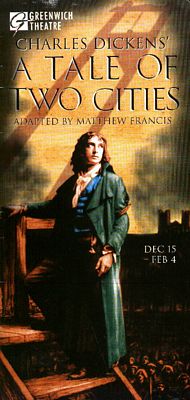A TALE OF TWO CITIES by
Charles Dickens
Adapted and Directed by Matthew Francis
Venue: Greenwich 1995

Adapted and Directed by Matthew Francis
Venue: Greenwich 1995

Cast
Review
| 1775:
RECALLED TO LIFE |
|
| Mr Jarvis Lorry | Bernard Lloyd |
| Miss Pross | Susan Porrett |
| Lucie Manette | Eleanor Tremain |
| 1757: DR
MANETTE |
|
| Dr Manette | Julian Forsyth |
| The Marquis St Evremond | Mark Saban |
| Evremonde | Alex Denison |
| Peasant Boy | Benedict Sandiford |
| 1775:
THE WINESHOP OF DEFARGE |
|
| Madame Defarge | Heather Tobias |
| Defarge | Iain Mitchell |
| 1780:
THE OLD BAILEY |
|
| Judge | Bernard Lloyd |
| Sydney Carton | Timothy Walker |
| 1st Spectator | Susan Porrett |
| 2nd Spectator | Heather Tobias |
| Attorney General | Charles Dale |
| Charles Darnay | Alexis Denisof |
| Mr John Barsad | Mark Saban |
| Mr Stryver | Iain Mitchell |
| Crown Witness | Benedict Sandiford |
| 1780:
FRANCE |
|
| Gaspard | Charles Dale |
| Peasant Woman | Heather Tobias |
| Gabelle | Charles Dale |
| 1789-94:
THE REVOLUTION |
|
| Governor of the Bastille | Charles Dale |
| Soldier | Alexis Denisof |
| Revolutionary | Mark Saban |
| 1st Aristocrat | Julian Forsyth |
| 2nd Aristocrat | Susan Porrett |
| 3rd Aristocrat | Timothy Walker |
| Revolutionary Judge | Benedict Sandiford |
| Public Prosecutor | Mark Saban |
| Chemist | Benedict Sandiford |
| President of the Tribunal | Mark Saban |
| Prosecutor | Charles Dale |
| Seamstress | Eleanor Tremain |
| Peasants Coachmen Postilions Revolutionaries Servants Redcaps Citizens |
|
Review
Greenwich Theatre's adaptation of Dickens' story of revolution, revenge and self-sacrifice is an ambitious affair. Director and adaptor Matthew Francis has sought to preserve the scope of the novel, including street scenes in London and scenes of revolution in Paris as well as most of Dickens' labyrinthine plot. The play opens with Doctor Manette's rescue after 18 years of incarceration and moves swiftly back in time to explain the circumstances of his imprisonment and then forward to his reunion with his daughter Lucie, his life in London and Lucie's marriage to Darnay. Julian Forsyth makes a dignified Manette, Bernard Lloyd as Mr Lorry and Susan Porrett as Miss Pross are wonderful comic characters while Eleanor Tremain copes well with the sickly sweet part of Lucie.
However the action moves at such a rate that it is difficult to get any feel for the characters. Francis has reproduced the structure of the novel in a long build-up to the action but he simply does not have the time to include the necessary detail. By the end of the first half, the French Revolution has not yet started and still a lot of the plot has had to be related in narrative. Sydney Carton, arguably the focal point of the story remains a peripheral figure until the very end of the play though Timothy Walker's sensitive performance manages to convey much of his character in his brief appearances. Francis has many ingenious ideas and with the aid of Julian McGowan's set gives a real feel of the range of the novel but at the expense of the play. The result is a beautifully staged, well acted but confusingly episodic production.